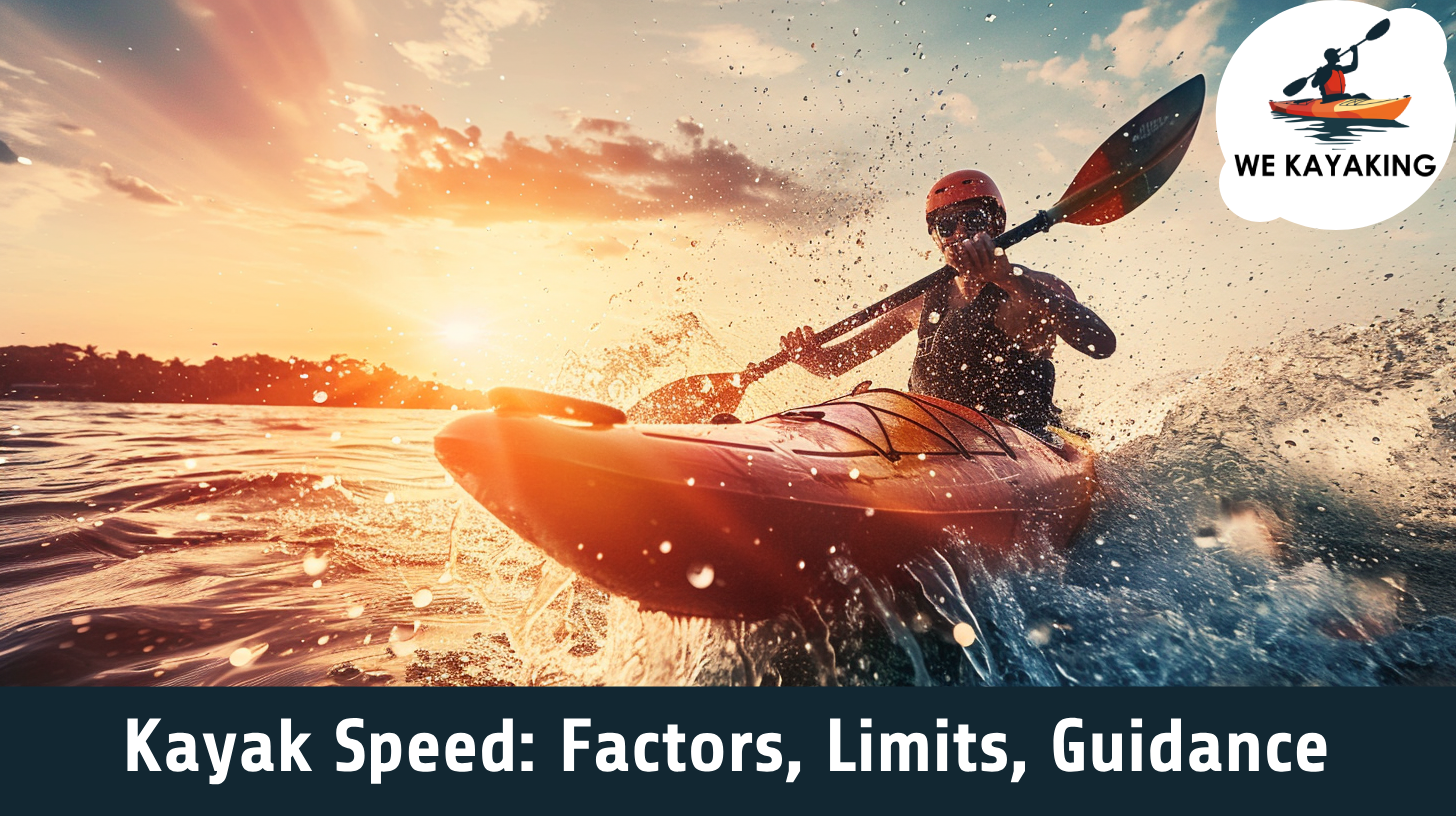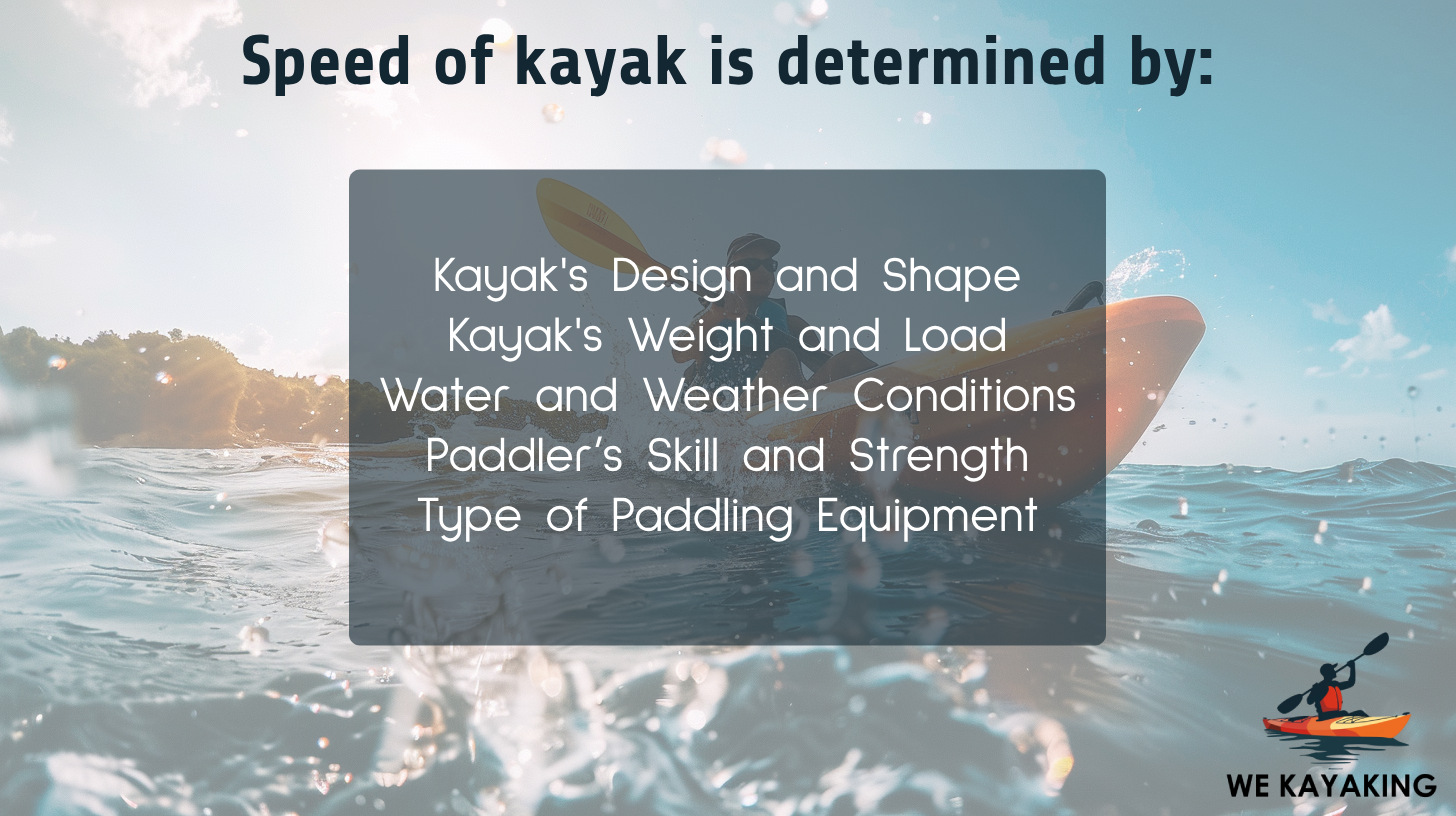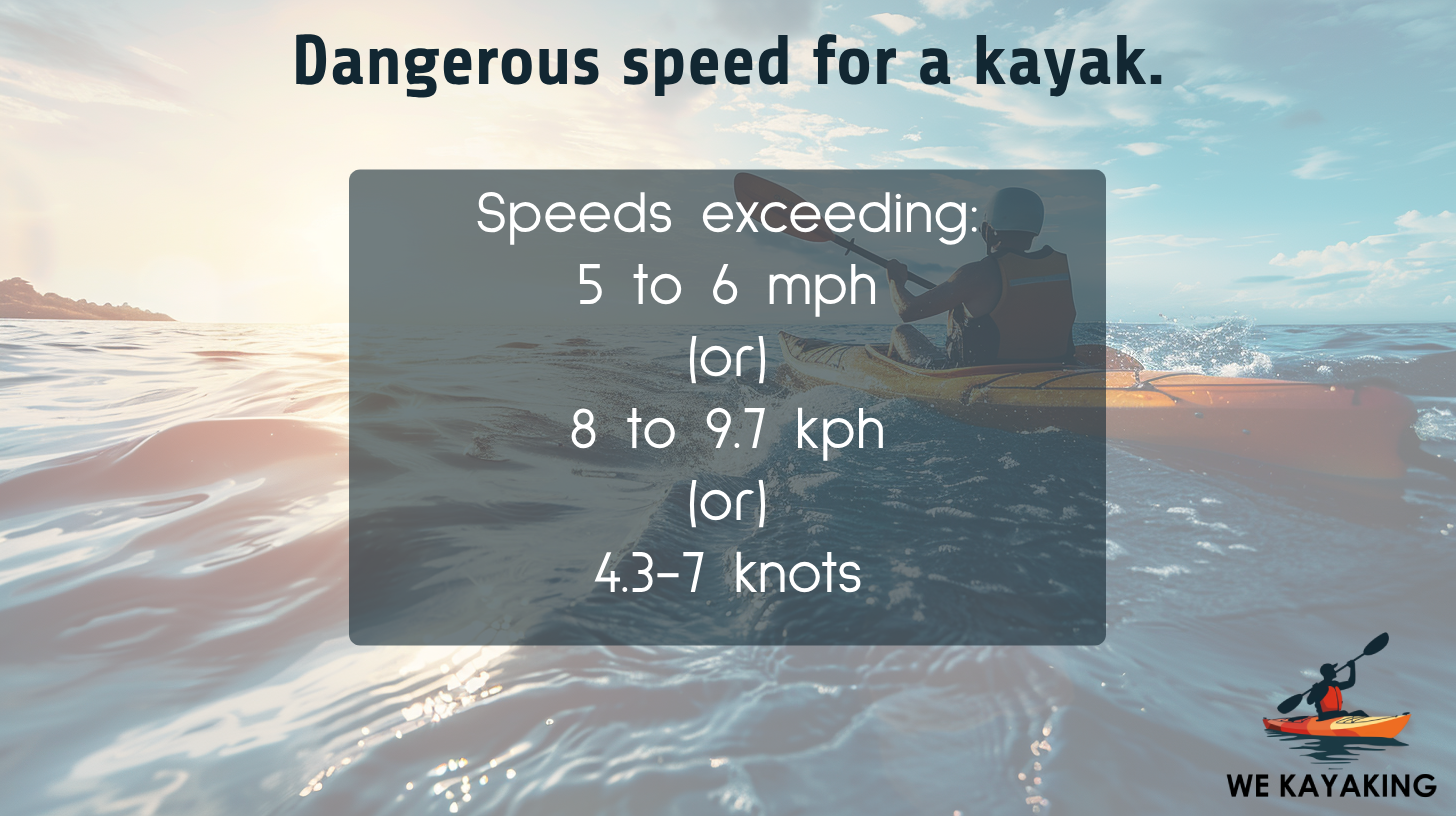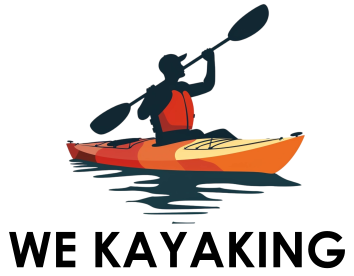
Kayak Speed: Factors, Limits, Guidance
The speed of a kayak is influenced by various factors. One of the primary determinants is the design and shape of the kayak. Longer and narrower kayaks are faster because they cut through the water more efficiently. The construction material also plays a role, with lighter and stiffer materials leading to quicker kayaks.
Additionally, the skill and strength of the paddler are crucial; experienced paddlers with better technique and physical ability achieve faster speeds. Environmental factors, such as water and weather conditions, also impact speed. Calm waters and favorable weather help attain higher speeds, whereas rough waters and strong winds slow the kayak down.
The load within the kayak, including any gear and supplies, also affects its speed; a heavier load will result in slower movement. Understanding these various elements is vital for paddlers to estimate their potential speed effectively and to select a kayak that meets their speed requirements, whether for relaxed paddling, touring, or competitive racing.
Table of Contents
What is the average speed of a kayak?
The average speed of a kayak is 3 to 5 mph (4.8 to 8 kph), or roughly 2.6 to 4.3 knots. This speed varies depending on factors such as the type of kayak, the skill of the paddler, and environmental conditions.
Recreational kayaks generally have slower speeds, while touring or racing kayaks achieve higher speeds. The paddler’s experience and strength, water currents, wind conditions, and the kayak’s weight also significantly influence the actual speed on the water. Advanced paddlers with efficient techniques maintain speeds at the higher end of this range, while beginners or those using less streamlined kayaks are at the lower end.
What type of kayak is the fastest?
The fastest type of kayak is the racing kayak. Racing kayaks are designed with speed as the primary focus. They are long, narrow, and lightweight, allowing them to cut through the water with minimal resistance. These kayaks are less stable than other types, requiring skill and experience to handle them effectively.
When choosing a kayak, if speed is your main objective, a racing kayak is the right choice. However, it’s important to consider your skill level, as these kayaks are less forgiving and more challenging to maneuver, especially for beginners.
What type of kayak is the slowest?
The slowest type of kayak is the recreational kayak. These kayaks are designed for stability and ease of use rather than speed. They are shorter and wider, which makes them more maneuverable but also creates more resistance in the water, leading to slower speeds.
When choosing a kayak, if your priority is leisurely paddling, stability, and comfort, especially in calm waters like lakes or slow-moving rivers, a recreational kayak is an ideal choice. Their design makes them very user-friendly for beginners or those who kayak for relaxation and enjoyment rather than speed.
What determines the speed of the kayak?
 The speed of a kayak is determined by several factors that include the following.
The speed of a kayak is determined by several factors that include the following.
- Design and Shape of the Kayak
- Weight and Load of the Kayak
- Water and Weather Conditions
- Paddler’s Skill and Strength
- Type of Paddling Equipment Used
The design and shape of the kayak, which includes the kayak’s length, width, and hull shape, significantly influence its speed. Longer and narrower kayaks slice through the water more efficiently, offering greater speed. A sleek and streamlined hull design reduces resistance, allowing the kayak to move faster.
The weight and load of the kayak, including any gear and supplies, affects its speed. A heavier kayak requires more effort to paddle and moves slower in the water. Properly distributing weight within the kayak helps maintain optimal performance.
Water and Weather Conditions are also determinants of a kayak’s overall speed. Calm and smooth water conditions allow for faster kayaking, while rough or choppy waters slow you down. Wind direction and strength also play a role in paddling against strong winds.
The paddler’s skill and strength also affect the kayaking speed. Experienced paddlers with good technique and strength are able to paddle more efficiently, maintaining higher speeds and better control. They know how to optimize each stroke for maximum propulsion and how to maintain a steady pace over longer distances.
The type of paddling equipment used determines how fast or slow the kayak moves. Paddles with larger blades provide more power per stroke, potentially increasing speed. However, they also require more strength, which leads to quicker fatigue. Lighter and more streamlined paddles allow for faster, more consistent strokes over time. The material of the paddle, such as carbon fiber or fiberglass, also impacts its efficiency and, consequently, the kayak’s speed.
It is important to consider these factors when choosing a kayak. You should give thought to how each of these factors will impact your experience based on your paddling goals, skill level, and the conditions you expect to encounter.
How to increase the speed of kayak?
To increase the speed of your kayak, first master efficient paddling techniques. This involves using your whole body, especially your core muscles, for each stroke to maximize power and minimize fatigue. Work on building your core strength through targeted exercises, as this is essential for powerful, sustained paddling.
The next steps to streamline your kayak by keeping the deck clear of unnecessary gear, reducing drag. Ensure you evenly distribute the weight inside your kayak for optimal stability and smoother movement through the water. Consider upgrading to a lighter, more efficient paddle to enhance your stroke power and effectiveness.
Consistently practice your paddling to improve strength, endurance, and technique. Regularly maintain your kayak, keeping the hull clean and in good repair to minimize resistance in the water.Choosing calmer waters for paddling and taking advantage of favorable wind conditions when possible to aid your speed. By focusing on these actions, you significantly increase your kayak’s speed.
What is the most efficient paddling technique for maximizing the speed of a kayak?
The most efficient technique for maximizing kayak speed is the forward stroke, which involves a combination of precise body positioning and controlled paddling strokes and movements. Start by sitting upright with a slight forward lean, engaging your core muscles, not just your arms, to power the stroke. Hold the paddle with hands slightly wider than shoulder-width apart, ensuring a relaxed yet firm grip. Begin the stroke (the catch phase) by fully submerging the blade near your feet.
During the power phase, push with your upper hand and pull with your lower hand, rotating your torso as the paddle moves through the water. Keep the blade close to the kayak for a straighter and more efficient path. Conclude the stroke (the exit phase) by lifting the paddle out of the water when it reaches your hip, then smoothly transition to the recovery phase, returning the blade to the starting position with minimal air resistance.
Ensure that your strokes are symmetrical on both sides and maintain a consistent rhythm.This method, which emphasizes using the entire body—especially the core—makes for strong, effective strokes that accelerate the kayak.
Is there a speed limit for kayaks?
No, there is no speed limit for kayaks. Unlike motorized vehicles on roads, kayaks don’t have regulated speed limits on waterways. However, the speed of a kayak is naturally limited by the paddler’s physical strength, the kayak’s design, and environmental conditions. Even the fastest racing kayaks, propelled by elite athletes, have their speed capped by these physical and design limitations.
Kayakers must also be mindful of local regulations and conditions. Some areas, especially crowded or ecologically sensitive ones, that have specific rules about speed to ensure safety and protect wildlife. Paddlers should always be aware of their surroundings and operate their kayak safely, respecting other water users and the environment.
What is the fastest possible speed of paddle kayak?
The fastest speed for a kayak is around 17-20 mph (27-32 km h) (14.7-17.3 knots). This speed is reached in sprint racing events, where paddlers use specialized equipment and techniques to maximize their speed over short distances.This speed, however, is not achievable for most kayakers and is achieved by highly trained athletes using racing kayaks. These specialized kayaks are designed for speed with long, narrow, and lightweight bodies.
For the average paddler using a recreational or touring kayak, the achievable speed is usually around 3 to 5 mph (4.8 to 8 kph). Factors such as the kayak’s design, the paddler’s skill and strength, water conditions, and the presence of wind or currents significantly influence the actual speed.
Racing kayaks, being streamlined for efficiency and speed, and paddled by experienced athletes, reach much higher speeds than recreational models. Nonetheless, these top speeds are exceptions and require exceptional physical conditioning, technique, and equipment.
How fast can a pedal kayak go?
A pedal kayak goes up to 3.5 to 5.5 mph (5.6 to 8.9 kph) (3-4.7 knots). This speed vary based on factors like the design of the kayak, the water conditions, and the user’s fitness level.
Pedal kayaks are propelled using a pedal system that drives a propeller or flippers beneath the kayak, allowing for efficient movement through the water. This mechanism enables higher speeds compared to traditional paddle kayaks, particularly over longer distances, as it allows the user to engage larger muscle groups in the legs. The hands-free operation also provides stability and control, making it a popular choice for fishing and touring.
However, the actual speed achieved in a pedal kayak is influenced by factors such as the kayak’s weight, the water’s current and chop, and the user’s pedaling strength and endurance. The efficiency of the pedal system and the kayak’s hydrodynamic design also play significant roles in determining its speed.
How fast can a motor kayak go?
A motor kayak reaches speeds of around 4 to 8 mph (6.4 to 12.9 kph) (3.4-7 knots). However, this varies widely based on the motor’s power, the kayak’s design, and the weight it’s carrying. Motorized kayaks are equipped with electric or gas motors, which provide more consistent propulsion than manual paddling.
The top speed depends on the motor’s horsepower and the kayak’s size and weight capacity. Lightweight, streamlined designs with powerful motors reach the higher end of this speed range, while heavier kayaks or those with less powerful motors will be on the lower end.
What is considered a dangerous speed on a kayak?
 In kayaking, what is considered a dangerous speed varies depending on the context and conditions. Speeds exceeding 5 to 6 mph (8 to 9.7 kph) (4.3-7 knots) in a kayak is considered dangerous for most recreational paddlers, especially in challenging conditions or crowded areas. This threshold is based on the average speed a recreational kayaker comfortably and safely maintains. Going faster than this, particularly in a non-racing kayak or in less-than-ideal conditions, increases the risk of capsizing and losing control.
In kayaking, what is considered a dangerous speed varies depending on the context and conditions. Speeds exceeding 5 to 6 mph (8 to 9.7 kph) (4.3-7 knots) in a kayak is considered dangerous for most recreational paddlers, especially in challenging conditions or crowded areas. This threshold is based on the average speed a recreational kayaker comfortably and safely maintains. Going faster than this, particularly in a non-racing kayak or in less-than-ideal conditions, increases the risk of capsizing and losing control.
Key factors that influence the speed of a kayak include the paddler’s skill level, as speeds too fast for one’s ability leads to loss of control and increased risk of capsizing. Environmental conditions play a crucial role; in areas with obstacles, heavy boat traffic, or strong currents. Lower speeds are safer to maintain control and react to sudden changes. The kayak’s design also matters; pushing a recreational kayak to speeds it’s not designed for is not safe.
Weather conditions are another important consideration. High winds and rough waters make higher speeds risky, even for experienced kayakers. Local regulations and the presence of other water users dictate what speeds are safe. Navigating crowded areas or ecologically sensitive zones requires slower, more cautious paddling.
In summary, a dangerous speed in a kayak is one that exceeds the paddler’s skill level, the kayak’s design limits, or the safety parameters set by the current environmental and regulatory conditions.
What is the optimal speed when kayaking on a river?
The optimal speed for kayaking on a river is 2 to 4 mph (3.2 to 6.4 kph) (1.7-3.4 knots). This speed range is comfortable for recreational kayakers and allows for effective maneuvering and control in various river conditions. The actual speed depends on several factors. The nature of the river current is a significant factor; in a fast-moving current, less paddling is required, and the kayak naturally moves faster. Conversely, in slow-moving sections, more active paddling is needed to maintain momentum.
What is the optimal speed when kayaking in the sea?
The optimal speed when kayaking in the sea for a recreational kayaker is 2 to 4 mph (3.2 to 6.4 kph) (1.7-3.4 knots). This speed allows for effective navigation, control, and enjoyment of the marine environment. Sea kayaking is influenced by various factors that affect optimal speed, such as the type of kayak, paddler’s experience, sea conditions, and the presence of currents and tides. Sea kayaks, designed for stability and efficiency in open water, maintain a steady pace even in choppy conditions. Experienced paddlers are able to navigate at the higher end of this speed range, even in moderate sea conditions, while beginners should stick to the lower end for safety.
What is the optimal speed when kayaking in the lake?
The optimal speed when kayaking on a lake for a recreational kayaker is generally around 2 to 3 mph (3.2 to 4.8 kph) (1.7-2.6 knots). This pace is ideal for most paddlers to enjoy the scenic environment and maintain good control of the kayak. On a lake, factors such as the absence of strong currents or tides, as found in sea or river kayaking, allow for a more relaxed and steady paddling experience. The calm and flat water conditions of a lake make it easier to maintain a consistent speed without exerting excessive effort.
Why does my kayak go slow?
Your kayak is going slow due to several factors, each impacting your speed in different ways. Inefficient paddling technique is a common cause; if you’re not using your core muscles effectively and relying mainly on arm strength, you’re likely not getting the most power out of each stroke.
The design of your kayak also plays a crucial role. Recreational kayaks, which are wider and shorter, are built for stability and ease of use rather than speed, making them inherently slower than touring or racing designs.
Overloading your kayak or distributing weight unevenly causes it to sit lower in the water, increasing drag and thereby slowing you down. Maintenance is another key factor; a kayak that is not well-maintained, with a dirty hull or damage, faces increased water resistance.
Environmental factors such as headwinds, currents against your direction, or choppy waters also reduce your kayak’s speed. Your physical condition affects paddling efficiency. If you’re physically tired, your stroke rate decreases, and your power output diminishes.
Lastly, using faulty or inappropriate equipment, like a paddle that’s not the right size or is damaged, negatively impacts your efficiency in the water.
Is it dangerous to go slow on a kayak?
Going at a slow pace in a kayak is safe and it even enhances the experience for those looking to relax or engage with the environment. However, it’s essential to maintain control of the kayak since maneuverability is less responsive at low speeds which is challenging in strong currents or windy conditions.
Does the paddle affect the speed of the kayak?
Yes. The paddle design, length, material, and paddling technique impact the speed of the kayak. The size and shape of the paddle blades affect the amount of water moved with each stroke, which in turn affects the speed of the kayak. Longer paddles cover more water per stroke, allowing for faster progress, but they tire the paddler more quickly.
The material used to construct the paddle also affect its performance. Lightweight materials, such as carbon fiber or fiberglass, reduce paddler fatigue and allow for a faster pace over more extended periods. Paddling technique is also crucial in determining the speed of the kayak. Efficient strokes that properly utilize the paddle’s design lead to greater speed and less energy expenditure.
In summary, the paddle plays a significant role in determining the speed of the kayak, and choosing the right paddle for the kayak and the paddler has a significant impact on performance.
Does the weight of the paddler affect the speed of the kayak?
Yes, the weight of the paddler affects the speed of the kayak. Heavier paddlers cause the kayak to sit lower in the water, which increases the water resistance or drag, and this leads to a reduction in speed. Conversely, lighter paddlers allow the kayak to sit higher, reducing drag and potentially increasing speed.
Are fast kayaks expensive?
Yes, fast kayaks are expensive. Their higher cost is due to specialized designs and materials used to enhance speed and efficiency. These kayaks often feature lightweight and durable materials like carbon fiber or advanced composites, contributing to higher prices.
A high-performance racing kayak costs anywhere from $2,000 to over $5,000 USD. In contrast, more basic recreational kayaks, which are not designed primarily for speed, are found in the range of $300 to $1,000 USD.
The cost reflects the kayak’s design complexity, material quality, and intended use. When looking for a fast kayak, it’s important to consider not only the price but also how its features align with your paddling skills and goals.
